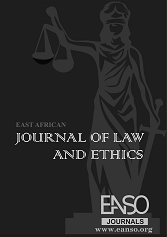Rights of Civilian Population When Counter-Terrorism during the Armed Conflict on War in Gaza
Abstract
This paper discusses the protection of the civilian population during armed conflict as a cornerstone of International Humanitarian Law, which provides a robust framework within which civilians are protected. The Geneva Convention of August 1949 and its Additional Protocols provide for the protection of the direct environment and property, also known as civilian objects. The nature of the protection accorded to civilians under International Humanitarian Law is seen through two main lenses. Firstly, this paper focuses on the implementation by the State parties to the Geneva Convention of August 1949 and its additional protocols, likewise the enforcement of the same by the State members. Nevertheless, this paper also speaks on whether the ongoing armed conflict between Israel forces and the Hamas military group adhere to the International Humanitarian law specifically the protection of Civilian population and what might be the major problem of not adhering to the Convention. Secondly, the finding of this paper depend on the Doctrinal and non-doctrinal as the method of data collection by analysing the law specifically the Geneva Convention of August 1949 and its additional protocol and statistics from different online sources including reports from websites. Finally, in the conclusion, this paper addresses the solution to the fundamental guarantees. Among other safeguards, everyone in the power of a party to a conflict is entitled to humane treatment without adverse distinction based on such criteria as race, colour, sex, language, religion, national origin or social status
Downloads
References
Charter of the United Nations (adopted 26 June 1945, entered into force 24 October 1945) 1 UNTS XVI
Geneva Convention I (wounded and sick in armed forces in the field):
Geneva Convention for the Amelioration of the Condition of the Wounded and Sick in Armed Forces in the Field (adopted 12 August 1949, entered into force 21 October 1950) 75 UNTS 31
Geneva Convention II (wounded, sick and shipwrecked at sea):
Geneva Convention for the Amelioration of the Condition of Wounded, Sick and Shipwrecked Members of Armed Forces at Sea (adopted 12 August 1949, entered into force 21 October 1950) 75 UNTS 85
Geneva Convention III (prisoners of war):
Geneva Convention Relative to the Treatment of Prisoners of War (adopted 12 August 1949, entered into force 21 October 1950) 75 UNTS 135
Geneva Convention IV (civilians):
Geneva Convention Relative to the Protection of Civilian Persons in Time of War (adopted 12 August 1949, entered into force 21 October 1950) 75 UNTS 287
International Covenant on Economic, Social and Cultural Rights (adopted 16 December 1966, entered into force 3 January 1976) 993 UNTS 3
International Covenant on Civil and Political Rights (adopted 16 December 1966, entered into force 23 March 1976) 999 UNTS 171
Universal Declaration of Human Rights (adopted 10 December 1948 UNGA Res 217 A(III)
Books, Journals and Articles
Emily Crawford and Alison Pert, International Humanitarian Law (2nd edn, Cambridge University Press 2020)
Marco S, International Humanitarian Law: Rules, Controversies, and Solutions to Problems Arising in Warfare (Edward Elgar Publishing 2019)
Nicholas Ts and Alasdair M, International Humanitarian Law: Cases, Materials and Commentary, Cambridge University Press
Andrew Clapham, Paola Gaeta and Marco Sassòli (eds), The 1949 Geneva Conventions: A Commentary (Oxford University Press 2018)
Ben Saul and Dapo Akande (eds), The Oxford Guide to International Humanitarian Law (Oxford University Press 2020)
Copyright (c) 2025 Anold Simeo

This work is licensed under a Creative Commons Attribution 4.0 International License.




























